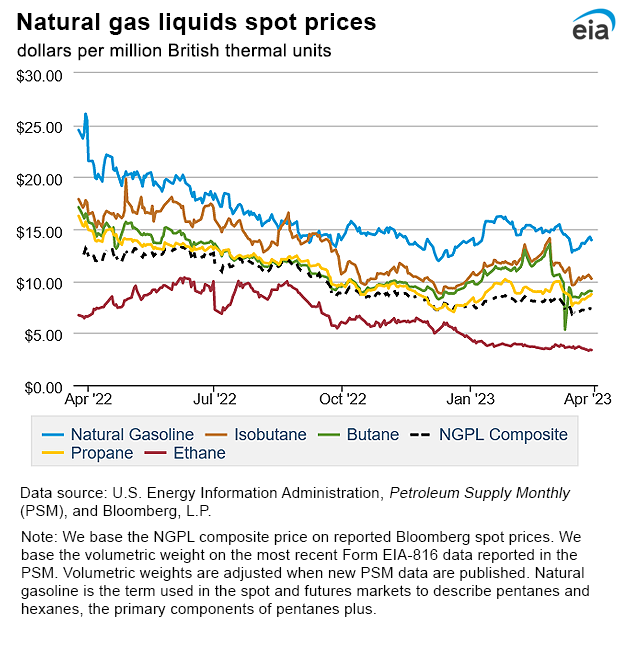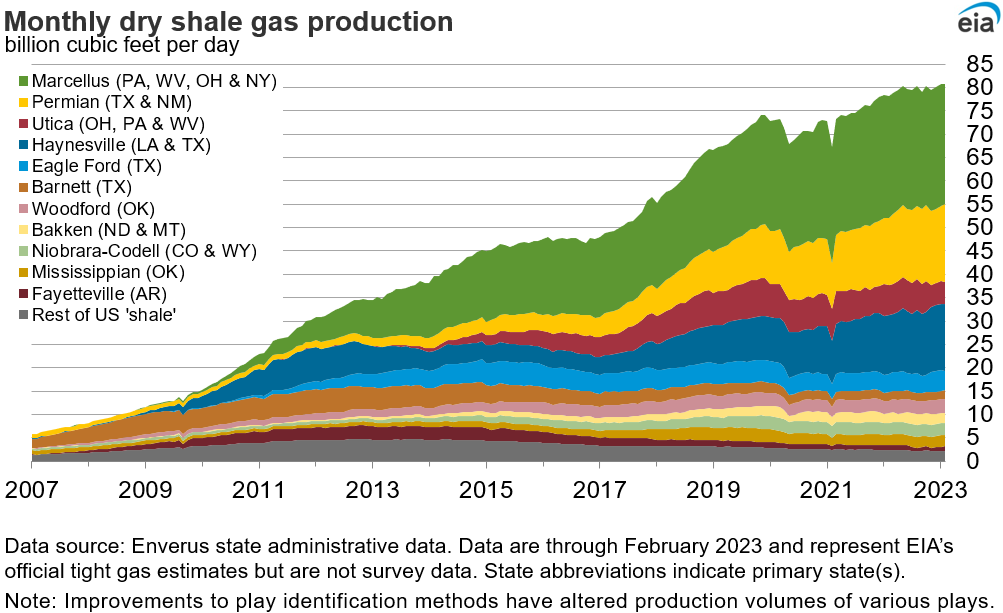In the News:
South Central storage withdrawals set a record low this winter heating season
Cumulative net withdrawals of natural gas from underground storage in the South Central storage region through the 20th Weekly Natural Gas Storage Report of this winter heating season from the week ending Friday, November 4, 2022 through the week ending Friday, March 17, 2023, have set a record low this winter heating season at 233 billion cubic feet (Bcf).
Natural gas storage helps balance supply and demand, particularly during the winter months when colder weather causes natural gas consumption to increase in response to increased demand for heating. As a result, withdrawals from and injections into storage are significantly influenced by temperatures and can vary regionally with weather patterns. Heating degree days (HDD) have been 13% below the 10-year (2013–2022) average in the South Central storage region this winter heating season, reducing the need to withdraw natural gas in response. As a result, natural gas consumption in the residential and commercial sectors in the South Central storage region was 13% below the five-year average this winter heating season, according to data from S&P Global Commodity Insights.
Increased production of natural gas has also contributed to below-average storage withdrawals in the South Central storage region this winter heating season. Several of the country’s major natural gas producing basins are centered there, including the Haynesville, Permian, Woodford, Eagle Ford, and Barnett. In addition, over 2 billion cubic feet per day (Bcf/d) of effective supply was available for U.S. domestic consumption due to the shutdown of the Freeport LNG terminal in Texas last summer.
With just over 1,550 Bcf of underground storage design capacity, the South Central storage region is the largest region by design capacity. And because high deliverability salt cavern storage facilities make up nearly 30% of working storage capacity in the region, storage flows are more responsive to changes in temperature compared with other storage regions. In fact, the South Central storage region has the highest maximum deliverability of any storage region, at 51.8 Bcf/d, compared with a range of 4.3 Bcf/d–28.2 Bcf/d in the other four storage regions, according to our estimates based on survey data. As a result, colder-than-normal winter temperatures in the South Central storage region typically result in large net withdrawals of natural gas from storage. However, due to above-normal temperatures in the region, large net withdrawals from storage in the South Central storage region have been uncommon this winter.
We maintain a Natural Gas Storage Dashboard with up-to-date national and regional data as well as commentary.
Market Highlights:
(For the week ending Wednesday, March 29, 2023)Prices
- Henry Hub spot price: The Henry Hub spot price fell 9 cents from $2.04 per million British thermal units (MMBtu) last Wednesday to $1.95/MMBtu yesterday.
- Henry Hub futures prices: The April 2023 NYMEX contract expired yesterday at $1.991/MMBtu, down 18 cents from last Wednesday. The last time the front month NYMEX contract settled below $2.00/MMBtu was on September 22, 2020, when it settled at $1.834/MMBtu. The May 2023 NYMEX contract price decreased to $2.184/MMBtu, down 12 cents from last Wednesday to yesterday. The price of the 12-month strip averaging May 2023 through April 2024 futures contracts declined 5 cents to $3.083/MMBtu.
- Select regional spot prices: Natural gas spot price changes were mixed this report week (Wednesday, March 22 to Wednesday, March 29). Price movements at major pricing hubs ranged from a decrease of $2.12/MMBtu at the PG&E Citygate in Northern California to an increase of $2.65/MMBtu at Malin on the California-Oregon border.
- Price movements at major pricing hubs in the eastern United States were mixed this week but were generally range-bound near or below $2.00/MMBtu, in line with the U.S. benchmark Henry Hub which was $1.95/MMBtu yesterday, down 9 cents from last Wednesday. At the Algonquin Citygate, which serves Boston-area consumers, the price went up 52 cents from $2.02/MMBtu last Wednesday to $2.54/MMBtu yesterday. At the Chicago Citygate, the price decreased 15 cents from $2.16/MMBtu last Wednesday to $2.01/MMBtu yesterday. Entering the shoulder season, demand for natural gas continues to decline; total U.S. demand is estimated to have averaged 6% (6.7 billion cubic feet per day [Bcf/d]) less than last week, led by decreased consumption in the Northeast (13%, or 2.9 Bcf/d) and Southeast (11%, or 2.0 Bcf/d) regions, according to data from S&P Global Commodity Insights.
- Prices at major pricing hubs west of the Rockies are elevated compared with prices in the rest of the United States, except for the price at Sumas on the Canada-Washington border, which fell 4 cents to $2.54/MMBtu yesterday. The price at Opal Hub in southwest Wyoming rose $2.39 from $3.38/MMBtu last Wednesday to $5.77/MMBtu yesterday. The price at Malin, Oregon, the northern delivery point into the PG&E service territory, rose $2.66 from $3.42/MMBtu last Wednesday to $6.08/MMBtu yesterday. The western half of the United States experienced below-average temperatures this report week. As a result, consumption of natural gas in the residential and commercial sectors increased 7% (0.1 Bcf/d) in the Rocky Mountain region and 20% (0.8 Bcf/d) in the Western region according to data from S&P Global Commodity Insights. Also contributing to the price increase is compressor maintenance reported by TC Energy on their Foothills system, which feeds into the Gas Transmission Northwest (GTN) system that serves the Pacific Northwest and delivers into the Malin, Oregon hub.
- Prices in California declined this week but were the highest among major pricing hubs in the United States. The price at PG&E Citygate in Northern California fell $2.12, down from $9.26/MMBtu last Wednesday to $7.14/MMBtu yesterday. The price at SoCal Citygate in Southern California decreased 53 cents from $9.78/MMBtu last Wednesday to $9.25/MMBtu yesterday. Consumption of natural gas in the residential and commercial sectors in California increased 23% (0.5 Bcf/d) this week according to data from S&P Global Commodity Insights, driven by below-average temperatures. In the Riverside Area, east of Los Angeles, temperatures averaged 53°F resulting in 79 heating degree days (HDD), 44 HDDs more than normal. Amid elevated demand and ongoing supply constraints, storage inventories of natural gas in the Pacific region remain low, contributing to upward price pressure.
- International futures prices: International natural gas futures price changes were mixed this report week. According to Bloomberg Finance, L.P., weekly average front-month futures prices for liquefied natural gas (LNG) cargoes in East Asia fell 51 cents to a weekly average of $12.72/MMBtu. Natural gas futures for delivery at the Title Transfer Facility (TTF) in the Netherlands rose 33 cents to a weekly average of $13.47/MMBtu. In the same week last year (week ending March 30, 2022), the prices were $34.22/MMBtu in East Asia and $35.16/MMBtu at TTF.
- Natural gas plant liquids (NGPL) prices: The natural gas plant liquids composite price at Mont Belvieu, Texas, rose by 23 cents/MMBtu, averaging $7.28/MMBtu for the week ending March 29. Ethane prices fell 6%, following natural gas prices at the Houston Ship Channel, which also fell 6% week over week. The ethane premium to natural gas narrowed by 6%. Ethylene spot prices rose 4%, widening the ethylene to ethane premium by 10%. The Brent crude oil price rose 3%, while propane prices rose 6%, resulting in a 2% decrease in the propane discount relative to crude oil. Normal butane and isobutane prices rose 4%, while the natural gasoline price rose 5%.
Daily spot prices by region are available on the EIA website.
Supply and Demand
- Supply: According to data from S&P Global Commodity Insights, the average total supply of natural gas fell by 0.7% (0.7 Bcf/d) compared with the previous report week. Dry natural gas production grew by 0.1% (0.1 Bcf/d) to an average of 101.0 Bcf/d, and average net imports from Canada decreased by 18.5% (0.9 Bcf/d) from last week.
- Demand: Total U.S. consumption of natural gas fell by 7.6% (6.6 Bcf/d) compared with the previous report week, according to data from S&P Global Commodity Insights. Natural gas consumed for power generation declined by 1.5% (0.4 Bcf/d), and industrial sector consumption decreased by 2.6% (0.6 Bcf/d) week over week. In the residential and commercial sectors, consumption declined by 16.6% (5.5 Bcf/d). Natural gas exports to Mexico were relatively flat this week. Natural gas deliveries to U.S. LNG export facilities (LNG pipeline receipts) averaged 13.0 Bcf/d, unchanged from last week.
Liquefied Natural Gas (LNG)
- Pipeline receipts: Overall natural gas deliveries to U.S. LNG export terminals were unchanged this week at 13.0 Bcf/d, according to data from S&P Global Commodity Insights. Natural gas deliveries to terminals in South Louisiana decreased by 3.4% (0.3 Bcf/d) to 8.1 Bcf/d, while deliveries to South Texas terminals increased by 9.0% (0.3 Bcf/d) to 3.7 Bcf/d. Natural gas deliveries to terminals in the Northeast were unchanged.
- Vessels departing U.S. ports: Twenty LNG vessels (seven from Sabine Pass; four from Corpus Christi; three each from Cameron and Freeport; and one each from Calcasieu Pass, Cove Point, and Elba Island) with a combined LNG-carrying capacity of 76 Bcf departed the United States between March 23 and March 29, according to shipping data provided by Bloomberg Finance, L.P.
- Vessels arriving at U.S. ports: One LNG vessel with a carrying capacity of 3 Bcf docked for off-loading at the Everett LNG terminal in Boston Harbor in Massachusetts between March 23 and March 29, according to shipping data provided by Bloomberg Finance, L.P. This delivery is the seventh to the terminal this winter heating season.
Rig Count
- According to Baker Hughes, for the week ending Tuesday, March 21, the natural gas rig count remained flat at 162, as an increase of 1 rig in the Cana Woodford was balanced by a decrease of 1 rig in unspecified producing regions. The number of oil-directed rigs rose by 4 to 593 rigs. There were gains of one rig in the DJ-Niobrara, three rigs in the Permian, and two in unspecified producing regions. The Granite Wash and the Mississippian both lost one rig. The total rig count, which includes 3 miscellaneous rigs, increased by 4, and it now stands at 758 rigs.
Storage
- Net withdrawals from storage totaled 47 Bcf for the week ending March 24, compared with the five-year (2018–2022) average net withdrawals of 17 Bcf and last year's net injections of 15 Bcf during the same week. Working natural gas stocks totaled 1,853 Bcf, which is 321 Bcf (21%) more than the five-year average and 442 Bcf (31%) more than last year at this time.
- According to The Desk survey of natural gas analysts, estimates of the weekly net change to working natural gas stocks ranged from net withdrawals of 36 Bcf to 61 Bcf, with a median estimate of 50 Bcf.
- The average rate of withdrawals from storage is 20% lower than the five-year average so far in the withdrawal season (November through March). If the rate of withdrawals from storage matched the five-year average for the remainder of the withdrawal season, the total inventory would be 1,853 Bcf on March 31, which is 321 Bcf higher than the five-year average of 1,532 Bcf for that time of year.
See also:
TopData source: U.S. Energy Information Administration
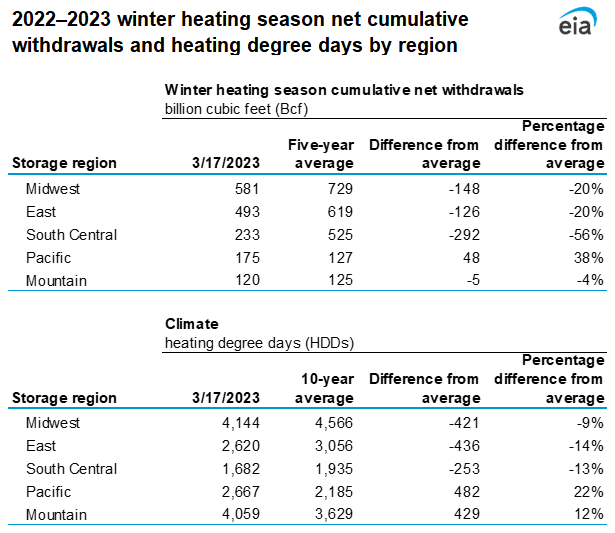
Data source: U.S. Energy Information Administration, National Oceanic and Atmospheric Administration, U.S. Census Bureau
Notes: 5-year averages of cumulative net withdrawals are for the 2017/18–2021/22 winter heating seasons through the 20th report week of the Natural Gas Storage Report of each season. 10-year heating degree day averages are daily averages for the years 2013–2022, population-weighted over storage regions using 2021 population estimates by county, and summed over the November 1–March 17 period.
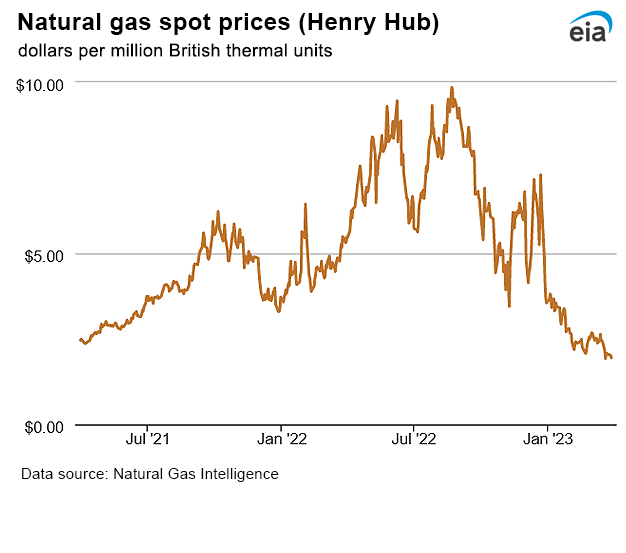
| Spot Prices ($/MMBtu) | Thu, 23-Mar |
Fri, 24-Mar |
Mon, 27-Mar |
Tue, 28-Mar |
Wed, 29-Mar |
|---|---|---|---|---|---|
| Henry Hub |
2.08 |
2.05 |
2.04 |
2.02 |
1.95 |
| New York |
1.85 |
1.91 |
1.96 |
1.98 |
1.95 |
| Chicago |
2.05 |
2.09 |
2.18 |
2.15 |
2.01 |
| Cal. Comp. Avg.* |
4.28 |
4.75 |
6.09 |
5.65 |
5.90 |
| Futures ($/MMBtu) | |||||
| April contract | 2.154 |
2.216 |
2.088 |
2.030 |
1.991 |
| May contract |
2.283 |
2.361 |
2.215 |
2.147 |
2.184 |
| *Avg. of NGI's reported prices for: Malin, PG&E Citygate, and Southern California Border Avg. | |||||
| Source: NGI's Daily Gas Price Index | |||||
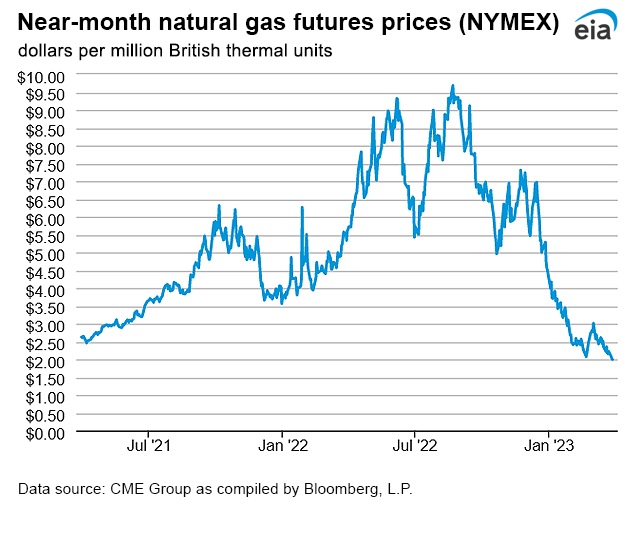
| U.S. natural gas supply - Gas Week: (3/23/23 - 3/29/23) | |||
|---|---|---|---|
Average daily values (billion cubic feet) |
|||
this week |
last week |
last year |
|
| Marketed production | 113.4 |
113.2 |
108.3 |
| Dry production | 101.0 |
100.8 |
95.4 |
| Net Canada imports | 3.9 |
4.7 |
5.1 |
| LNG pipeline deliveries | 0.1 |
0.1 |
0.1 |
| Total supply | 104.9 |
105.7 |
100.7 |
|
Data source: S&P Global Commodity Insights | |||
| U.S. natural gas consumption - Gas Week: (3/23/23 - 3/29/23) | |||
|---|---|---|---|
Average daily values (billion cubic feet) |
|||
this week |
last week |
last year |
|
| U.S. consumption | 79.3 |
85.8 |
79.7 |
| Power | 28.5 |
28.9 |
24.8 |
| Industrial | 23.2 |
23.9 |
24.1 |
| Residential/commercial | 27.6 |
33.1 |
30.9 |
| Mexico exports | 5.1 |
5.1 |
5.3 |
| Pipeline fuel use/losses | 7.1 |
7.3 |
6.8 |
| LNG pipeline receipts | 13.0 |
13.0 |
13.2 |
| Total demand | 104.5 |
111.2 |
105.1 |
|
Data source: S&P Global Commodity Insights | |||
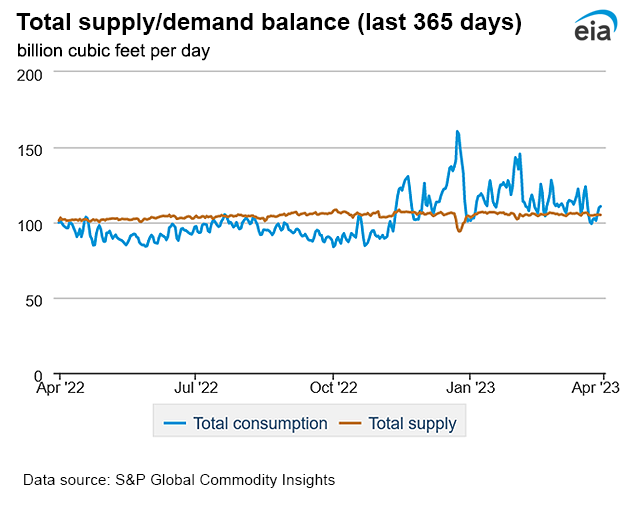
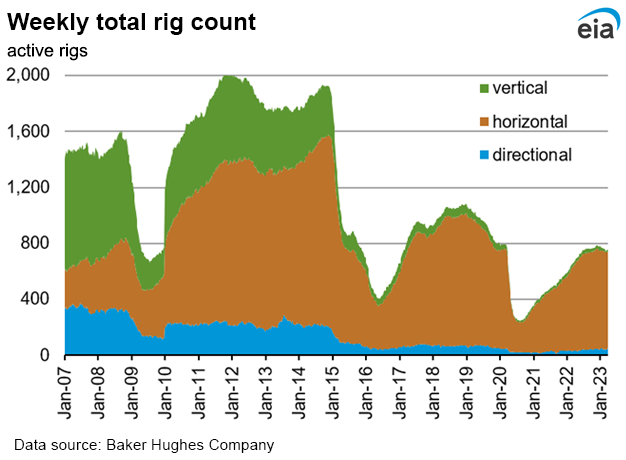
| Rigs | |||
|---|---|---|---|
Tue, March 21, 2023 |
Change from |
||
last week |
last year |
||
| Oil rigs | 593 |
0.7% |
11.7% |
| Natural gas rigs | 162 |
0.0% |
18.2% |
| Note: Excludes any miscellaneous rigs | |||
| Rig numbers by type | |||
|---|---|---|---|
Tue, March 21, 2023 |
Change from |
||
last week |
last year |
||
| Vertical | 16 |
6.7% |
-36.0% |
| Horizontal | 692 |
0.0% |
13.4% |
| Directional | 50 |
6.4% |
42.9% |
| Data source: Baker Hughes Company | |||
| Working gas in underground storage | ||||
|---|---|---|---|---|
Stocks billion cubic feet (Bcf) |
||||
| Region | 2023-03-24 |
2023-03-17 |
change |
|
| East | 343 |
355 |
-12 |
|
| Midwest | 437 |
461 |
-24 |
|
| Mountain | 82 |
84 |
-2 |
|
| Pacific | 73 |
72 |
1 |
|
| South Central | 917 |
927 |
-10 |
|
| Total | 1,853 |
1,900 |
-47 |
|
| Data source: U.S. Energy Information Administration Form EIA-912, Weekly Underground Natural Gas Storage Report | ||||
| Working gas in underground storage | |||||
|---|---|---|---|---|---|
Historical comparisons |
|||||
Year ago (3/24/22) |
5-year average (2018-2022) |
||||
| Region | Stocks (Bcf) |
% change |
Stocks (Bcf) |
% change |
|
| East | 268 |
28.0 |
285 |
20.4 |
|
| Midwest | 317 |
37.9 |
346 |
26.3 |
|
| Mountain | 89 |
-7.9 |
89 |
-7.9 |
|
| Pacific | 160 |
-54.4 |
164 |
-55.5 |
|
| South Central | 578 |
58.7 |
648 |
41.5 |
|
| Total | 1,411 |
31.3 |
1,532 |
21.0 |
|
| Data source: U.S. Energy Information Administration Form EIA-912, Weekly Underground Natural Gas Storage Report | |||||
| Temperature – heating & cooling degree days (week ending Mar 23) | ||||||||
|---|---|---|---|---|---|---|---|---|
HDDs |
CDDs |
|||||||
| Region | Current total |
Deviation from normal |
Deviation from last year |
Current total |
Deviation from normal |
Deviation from last year |
||
| New England | 173 |
-18 |
45 |
0 |
0 |
0 |
||
| Middle Atlantic | 165 |
-11 |
57 |
0 |
0 |
0 |
||
| E N Central | 207 |
23 |
91 |
0 |
0 |
0 |
||
| W N Central | 238 |
54 |
98 |
0 |
-1 |
0 |
||
| South Atlantic | 125 |
24 |
68 |
7 |
-5 |
-10 |
||
| E S Central | 144 |
48 |
85 |
0 |
-5 |
0 |
||
| W S Central | 96 |
40 |
45 |
10 |
-3 |
4 |
||
| Mountain | 193 |
42 |
37 |
0 |
-2 |
-1 |
||
| Pacific | 117 |
30 |
55 |
0 |
-1 |
0 |
||
| United States | 164 |
25 |
68 |
2 |
-3 |
-1 |
||
|
Data source: National Oceanic and Atmospheric Administration Note: HDDs=heating degree days; CDDs=cooling degree days | ||||||||
Average temperature (°F)
7-day mean ending Mar 23, 2023
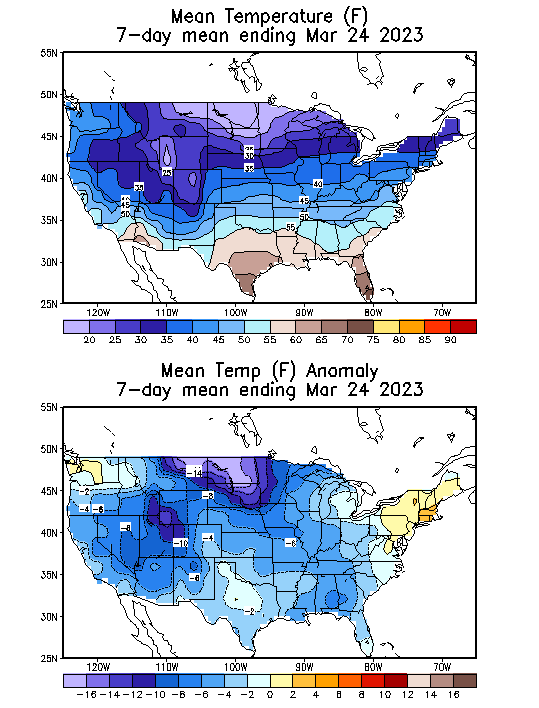
Data source: National Oceanic and Atmospheric Administration
Deviation between average and normal temperature (°F)
7-day mean ending Mar 23, 2023

Data source: National Oceanic and Atmospheric Administration

